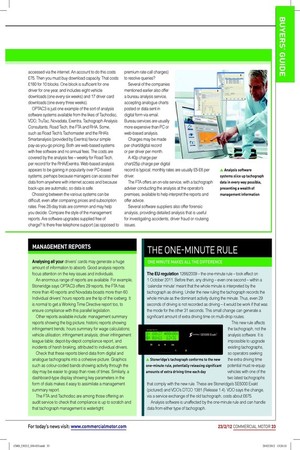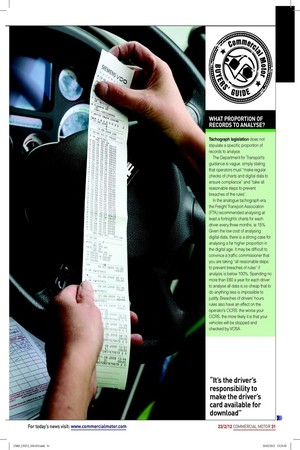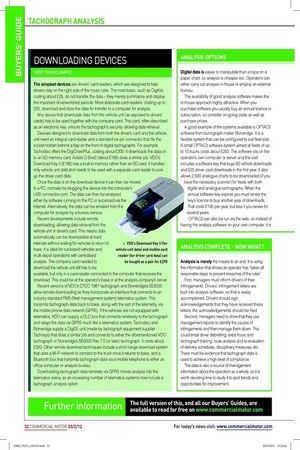THIS WEEK WE LOOK AT...
Page 23

Page 26

Page 24

Page 25

If you've noticed an error in this article please click here to report it so we can fix it.
The switch from analogue to digital may have made drivers’ lives easier, but it hasn’t changed the need to analyse your tacho recordings correctly
s became mandatory in trucks irst registered on or after 1 May 2006, sweeping away 25 years of analogue tachographs and paper charts. What has not changed, however, is the need to analyse tachograph data to ensure that drivers comply with the EU drivers’ hours rules and do not jeopardise their employer’s O-licence.
Analogue tachographs are not yet museum pieces and we are in the transition phase where many leets must manage data from both types of instrument.
Digital tachograph
Downloading data
One of the key differences between the two types of instruments is that a digital tachograph stores data in two places: the instrument itself (the vehicle unit) and the driver’s card. This means there are two download procedures. The vehicle unit holds 365 days of data but the law demands that operators must download it at least every 56 days. The vehicle unit records all the vehicle activity, including tachograph faults and periods when the truck was driven without a driver’s card in the correct slot.
The driver’s card holds 28 days of data and must be downloaded before that limit is reached. The driver’s card records only the activity of that particular driver. Downloading from either source copies the data but does not delete it, so data remains on the vehicle unit and card until their memories are full and the oldest data is overwritten.
It is the operator’s responsibility to download the data from both sources, but it is the driver’s responsibility to make the driver’s card available for downloading.
Some favour frequent downloading – every 14 or 28 days for the vehicle unit, say, and perhaps even daily for the driver’s card – because issues can be identiied sooner.
Data certainly should be downloaded as soon as possible after an accident: detailed speed data is retained in the vehicle unit’s memory for just 24 hours before it is overwritten. Cards held by agency drivers should be downloaded before they start work to ensure they have suficient hours for their shift. accessed via the internet. An account to do this costs £75. Then you must buy download capacity. That costs £180 for 10 blocks. One block is sufficient for one driver for one year, and includes eight vehicle downloads (one every six weeks) and 17 driver card downloads (one every three weeks).
OPTAC3 is just one example of the sort of analysis software systems available from the likes of Tachodisc, VDO, TruTac, Novadata, Exentra, Tachograph Analysis Consultants, Road Tech, the FTA and RHA. Some, such as Road Tech’s Tachomaster and the RHA’s Smartanalysis (provided by Exentra) favour simple pay-as-you-go pricing. Both are web-based systems with free software and no annual fees. The costs are covered by the analysis fee – weekly for Road Tech, per record for the RHA/Exentra. Web-based analysis appears to be gaining in popularity over PC-based systems, perhaps because managers can access their data from anywhere with internet access and because back-ups are automatic, so data is safe.
Choosing between the various systems can be difficult, even after comparing prices and subscription rates. Free 28-day trials are common and may help you decide. Compare the style of the management reports. Are software upgrades supplied free of charge? Is there free telephone support (as opposed to premium rate call charges) to resolve queries?
Several of the companies mentioned earlier also offer a bureau analysis service, accepting analogue charts posted or data sent in digital form via email. Bureau services are usually more expensive than PC or web-based analysis.
Charges may be made per chart/digital record or per driver per month.
A 40p charge per chart/25p charge per digital record is typical; monthly rates are usually £5-£6 per driver.
The FTA offers an on-site service, with a tachograph adviser conducting the analysis at the operator’s premises, available to help interpret the reports and offer advice.
Several software suppliers also offer forensic analysis, providing detailed analysis that is useful for investigating accidents, driver fraud or routeing issues.
RECORD KEEPING
Digital drivers’ hours data has to be retained (in its raw binary form, not post-analysis) for at least a year, the same as analogue charts. It makes sense to keep analysis of the data for at least a year in case VOSA raises queries. It pays to keep all data and analysis for at least two years. That is the period for which working time records must be kept to satisfy the Road Transport (Working Time) Regulations 2005. Although the two sets of rules are different, drivers’ hours analysis software usually checks for compliance of working time regulations too, so keeping everything for two years satisfies both requirements.
If a driver is employed by an agency it is the agency that is responsible for working time compliance. However, the operator the driver works for is responsible for drivers’ hours compliance and should ensure the cards of all agency drivers are downloaded once they have finished their placement.
WHAT PROPORTION OF RECORDS TO ANALYSE?
Tachograph legislation does not stipulate a specific proportion of records to analyse.
The Department for Transport’s guidance is vague, simply stating that operators must “make regular checks of charts and digital data to ensure compliance” and “take all reasonable steps to prevent breaches of the rules”.
In the analogue tachograph era, the Freight Transport Association (FTA) recommended analysing at least a fortnight’s charts for each driver every three months, ie 15%. Given the low cost of analysing digital data, there is a strong case for analysing a far higher proportion in the digital age. It may be difficult to convince a traffic commissioner that you are taking “all reasonable steps to prevent breaches of rules” if analysis is below 100%. Spending no more than £60 a year for each driver to analyse all data is so cheap that to do anything less is impossible to justify. Breaches of drivers’ hours rules also have an effect on the operator’s OCRS: the worse your OCRS, the more likely it is that your vehicles will be stopped and checked by VOSA.
DOWNLOADING DEVICES
KEEP THINGS SIMPLE
▲ VDO’s Download Key II (for vehicle unit data) and mobile card reader (for driver card data) can be bought as a pair for £295
The simplest devices are drivers’ card readers, which are designed to help drivers stay on the right side of the hours rules. The most basic, such as Digifob, costing about £25, do not transfer the data – they merely summarise and display the important drive/work/rest periods. More elaborate card readers, costing up to £50, download and store the data for transfer to a computer for analysis.
Any device that downloads data from the vehicle unit (as opposed to drivers’ cards) has to be used together with the company card. This card, often described as an electronic key, unlocks the tachograph’s security, allowing data retrieval.
Devices designed to download data from both the driver’s card and the vehicle unit need an integral card reader and a standard six-pin connector that fits the socket hidden behind a flap on the front of digital tachographs. For example, Tachodisc offers the DigiDownPlus, costing about £200. It downloads the data on to an SD memory card. Actia’s D-Box2 (about £185) does a similar job. VDO’s Download Key II (£195) has a built-in memory rather than an SD card. It handles only vehicle unit data and needs to be used with a separate card reader to pick up the driver card data.
Once the data is on the download device it can then be moved to a PC, normally by plugging the device into the computer’s USB connection port. The data can then be analysed, either by software running on the PC or accessed via the internet. Alternatively, the data can be emailed from the computer for analysis by a bureau service.
Recent developments include remote downloading, allowing data retrieval from the vehicle unit or driver’s card. This means data automatically can be downloaded at fixed intervals without waiting for vehicles to return to base. It is ideal for out-based vehicles and multi-depot operations with centralised analysis. The company card needed to download the vehicle unit still has to be available, but only in a card-reader connected to the computer that receives the download. This could be at the operator’s base or at the analysis company’s server.
Recent versions of VDO’s DTCO 1381 tachograph and Stoneridge’s SE5000 allow remote downloading as they incorporate an interface that connects to an industry standard FMS (fleet management system) telematics system. This transmits tachograph data back to base, along with the rest of the telemetry, via the mobile phone data network (GPRS). If the vehicles are not equipped with telematics, VDO can supply a DLD box that connects wirelessly to the tachograph and relays the data via GPRS much like a telematics system. Tachodisc and Stoneridge supply a DigiDL unit (made by tachograph equipment supplier Tachosys) that does a similar job and connects to either the aforementioned VDO tachograph or Stoneridge’s SE5000 Rev 7.0 (or later) tachograph. It costs about £300. Other remote download techniques include a short-range download system that uses a Wi-Fi network to connect to the truck once it returns to base, and a Bluetooth box that transmits tachograph data via a mobile telephone to either an office computer or analysis bureau.
Downloading tachograph data remotely via GPRS moves analysis into the telematics arena, so an increasing number of telematics systems now include a tachograph analysis option.
ANALYSIS OPTIONS
Digital data is easier to manipulate than a trace on a paper chart, so analysis is cheaper too. Operators can either carry out analysis in-house or employ an external bureau.
The availability of good analysis software makes the in-house approach highly attractive. When you purchase software you usually buy an annual licence or subscription, so consider on-going costs as well as purchase prices.
A good example of the systems available is OPTAC3 software from tachograph maker Stoneridge. It is a flexible system that can be configured to suit fleet size. A small OPTAC3 software system aimed at fleets of up to 10 trucks costs about £250. The software sits on the operator’s own computer or server and the cost includes a software key that buys 80 vehicle downloads and 520 driver card downloads in the first year. It also allows 2,500 analogue charts to be downloaded (if you have the necessary scanner) for fleets with both digital and analogue tachographs. When the annual software key expires you must renew the key’s licence to buy another year of downloads. That costs £195 per year, but less if you renew for several years.
OPTAC3 can also be run via the web, so instead of having the analysis software on your own computer, it is
ANALYSIS COMPLETE – NOW WHAT?
Analysis is merely the means to an end. It is using the information that shows an operator has “taken all reasonable steps to prevent breaches of the rules”.
First, managers must inform drivers of their infringements. Drivers’ infringement letters are built into analysis software, so that is easily accomplished. Drivers should sign acknowledgements that they have received these letters; the acknowledgements should be filed.
Second, managers need to show that they use management reports to identify the causes of infringements and then manage them down. This could entail driver debriefing, extra hours and tachograph training, route analysis and re-evaluation of delivery schedules, disciplinary measures, etc. There must be evidence that tachograph data is used to achieve a high level of compliance.
The data is also a source of management information about the operation as a whole, so it is worth devoting time to study it to spot trends and opportunities for improvement.
MANAGEMENT REPORTS
Analysing all your drivers’ cards may generate a huge amount of information to absorb. Good analysis reports focus attention on the key issues and individuals.
An enormous range of reports are available. For example, Stoneridge says OPTAC3 offers 29 reports, the FTA has more than 40 reports and Novadata boasts more than 60. Individual drivers’ hours reports are the tip of the iceberg. It is normal to get a Working Time Directive report too, to ensure compliance with this parallel legislation.
Other reports available include: management summary reports showing the big picture; historic reports showing infringement trends; hours summary for wage calculations; vehicle utilisation; infringement analysis; driver infringement league table; depot-by-depot compliance report, and incidents of harsh braking, attributed to individual drivers.
Check that these reports blend data from digital and analogue tachographs into a cohesive picture. Graphics such as colour-coded bands showing activity through the day may be easier to grasp than rows of times. Similarly, a dashboard-type display showing key parameters in the form of dials makes it easy to assimilate a management summary report.
The FTA and Tachodisc are among those offering an audit service to check that compliance is up to scratch and that tachograph management is watertight.
THE ONE-MINUTE RULE
ONE MINUTE MAKES ALL THE DIFFERENCE
▲ Stoneridge’s tachograph conforms to the new one-minute rule, potentially releasing significant amounts of extra driving time each day
The EU regulation 1266/2009 – the one-minute rule – took effect on 1 October 2011. Before then, any driving – even one second – within a ‘calendar minute’ meant that the whole minute is interpreted by the tachograph as driving. Under the new ruling the tachograph records the whole minute as the dominant activity during the minute. Thus, even 29 seconds of driving is not recorded as driving – it would be work if that was the mode for the other 31 seconds. This small change can generate a significant amount of extra driving time on multi-drop routes.
This new rule affects the tachograph, not the analysis software. It is impossible to upgrade existing tachographs, so operators seeking the extra driving time potential must re-equip vehicles with one of the two latest tachographs that comply with the new rule. These are Stoneridge’s SE5000 Exakt (pictured) and VDO’s DTCO 1381 (Release 1.4). VDO says the change, via a service exchange of the old tachograph, costs about £675.
Analysis software is unaffected by the one-minute rule and can handle data from either type of tachograph.












































